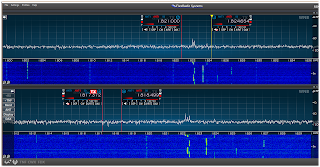You can see on this map the two entities displayed. FT4JA is the blue dot next to Madagascar and VK0EK is the sub antartic red dot at the tip of my mouse cursor. So how do 2 DX peditions, #4 most wanted and #5 most wanted pileups coexist on the same band? They make a co-ordinated plan.
This is the plan for 160M
The VK0EK pileup is planned to occur in the red zone and FT4JA's pileup is planned to occur in the blue zone. Tonight I got to see the plan in action and it worked quite well. The 2 DX-peditions had NO cross interference.
The upper panadapter is devoted to FT4JA. You can see 2 slices A&B are devoted to him. VK0EK is the lower panadapter. Slices C&D are devoted to him. 2.5 khz separate the pileups.
Here is a shot of the whole thing displayed on 1 skimmer
FT4JA is transmitting on 1821khz and VK0EK on 1818.5khz. There is a lot of RF slinging around the band yet my band noise is about -110dBm on my vertical. If I want to call FT4JA I set the TX Flag to slice B as above. If I want to call VK0EK I set the TX Flag on Slice D.
Both stations are represented in my headphones and I have VK0EK toward the left and FT4JA toward the right
I can set my TX freq simply by clicking the proper TX slice and moving it where I want. You will note I have the blue locks applied to the RX slices so If I grab the wrong slice it won't move. The plan sounds good in theory but with the 6500 it plays for me in multiple dimensions. I don't think any other radio save the 6700 has this kind of versatility.
This radio was built from the ground up as a screaming DX machine. It is flat out amazing. I haven't worked them yet but we will see. I would LOVE to get either one of these jokers on 160.
Here is the setup converted from 160/160 to 160M and 40M. It took less than a minute to convert. I lost VK0EK on 160M but I was able to hear him on 40M so I merely switch the VH0EK slice pair C&D from 160M over to 40M and open a second skimmer, and turned on the correct DAX feed, so I have one skimmer for 160M and one for 40M.
Using SDR-Bridge with these 2 slice pairs allows me to set up click tuning on the skimmer screens such that I can tune pairs A&B, and C&D totally independently.
By setting the correct Split flags in SDR-Bridge I am able to click tune around either pileup while searching for the correct TX freq to answer either DX station. Click tuning the 40M skimmer sets my TX to 40M and clicking the 160M pileup sets my TX to 160M. Since my amp and antenna follow my TX choice one click and I am ready to make the call. I can also turn on full duplex.
To make this effective I set my RX antenna to my broad band loop and I can run full duplex on 40M and 160M receive while my transmit antennas and amp band follows my transmitter. This means I can listen 100% of the time to VK0EK on 40M, while calling FT4JA on 160M. If I decide to call VK0EK on 40 I never loose FT4JA in my headphones even while transmitting.
This is a picture of me transmitting 1110W of CW to a half wave vertical on 7.0167 mhz on 40M while listening to a S3 carrier on 1.825 mhz. My TX and RX antennas are separated by a couple hundred feet. My band noise on the RX loop on 160 is -120 dBm (S1). It rises to about -118 dBm (still S1) when transmitting 1110W a couple hundred feet away.
73 W9OY











